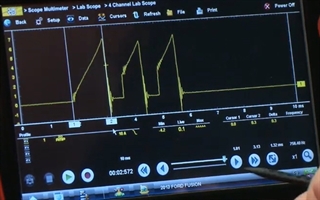 There are many different ways to diagnose ignition problems on a vehicle using a Snap-on® lab scope.
There are many different ways to diagnose ignition problems on a vehicle using a Snap-on® lab scope.
You might be facing a faulty ignition coil or something similar but you’re having a difficult time trying to get to the bottom of things.
One way to work your way to a solution is to run what’s called a Coil Current Ramp Test, which operates with the aid of the diagnostic software on Snap-on platforms.
With your low amps probe hooked up around one of the wires on the vehicle’s number one coil, in your lab scope settings make sure you’re on a 10 amp scale and a 10 millisecond sweep.
Once you’re recording, start the vehicle and generate some data for a few seconds before pausing the recording and switching off the vehicle.
For this example we’re working on a 2013 Ford Fusion as it uses what’s called a multi-strike ignition, which is trying to dissipate all of the extra energy in the coil by firing multiple times.
Doing this also helps the fuel burn more efficiently when the vehicle is idle. Some BMW models use four or five multiple strikes just to dispel the energy.
Back on the lab scope, turn on your cursors and take a better look at the timing of the pattern.
Measure the first strike, because that’s the one you should be most concerned about. In this example we got 1.32 milliseconds, which is well within a good average of one and a half milliseconds.
You want to make sure that the current ramp is nice and smooth. If it ramped up very quickly then you would have an issue with a high current flowing through that coil driver.
And it’s important to make sure that the pattern is straight – anything with a curve would show another issue with the coil.
This is a pretty simple and unobtrusive test you can run to make your life easier when it comes to ignition coil diagnosis.